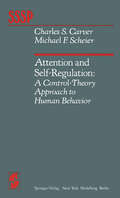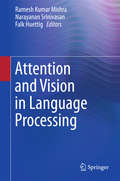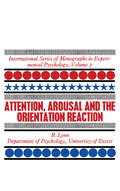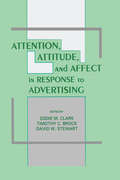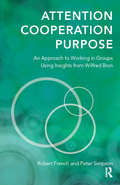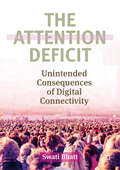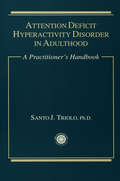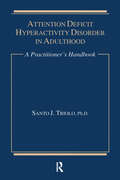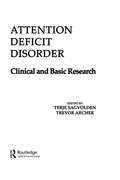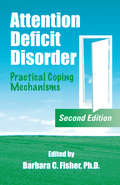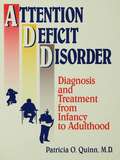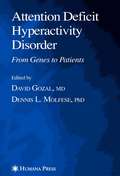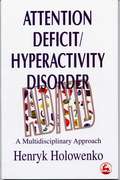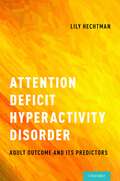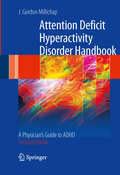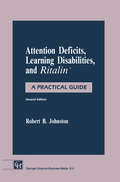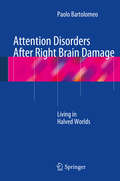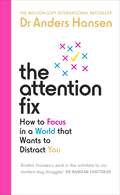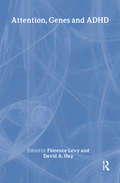- Table View
- List View
Attention and Self-Regulation: A Control-Theory Approach to Human Behavior (Springer Series in Social Psychology)
by C. S. Carver M. F. Scheier"Seek simplicity and distrust it. " Alfred North Whitehead "It will become all too clear that an ability to see patterns in behavior, an ability that some might feel proud of, can lead more easily to a wrong description than a right one. " William T. Powers The goal of the theorist-the scholar-is to take a collection of observations of the world, and perceive order in them. This process necessarily imposes an artificial simplicity upon those observations. That is, specific observations are weighed differently from each other whenever a theoretical account is abstracted from raw experiences. Some observed events are misunderstood or distorted, others are seen as representing random fluctuations and are ignored, and yet others are viewed as centrally important. This abstraction and oversimplification of reality is inevitable in theory construction. Moreover, the abstracted vision builds upon itself. That is, as a structure begins to emerge from continued observation, the structure itself guides the search for new information. The result is a construction that is more elaborate than what existed before, but it still is usually simpler than reality. It is important for scholars to believe in the value of their task, and in the general correctness of the vision that guides their work. This commitment, and the hope of progress that follows from it, make it possible to continue even when the work is difficult and slow.
Attention and Vision in Language Processing
by Ramesh Kumar Mishra Narayanan Srinivasan Falk HuettigThis volume provides a comprehensive overview of the nature of attentional and visual processes involved in language comprehension. Key concerns include how linguistic and non-linguistic processes jointly determine language comprehension and production and how the linguistic system interfaces with perceptual systems and attention. Language scientists have traditionally considered language in isolation from other cognitive and perceptual systems such as attention, vision and memory. In recent years, however, it has become increasingly clear that language comprehension must be studied within interaction contexts. The study of multimodal interactions and attentional processes during language processing has thus become an important theoretical focus that guides many research programs in psycholinguistics and related fields.
Attention, Arousal and the Orientation Reaction: International Series of Monographs in Experimental Psychology
by R. LynnAttention, Arousal and the Orientation Reaction aims to present in a volume the works of Pavlov, an eminent Russian physiologist known for his contributions, specifically the classical conditioning. This book contains the interpretations and theories in physiological terms, and elaborates on the neurological models of significant interest. The “orientation reaction†is described, and the Sokolov's model, which is claimed to be the most comprehensive model for the orientation reaction, is then illustrated. This text also explains the phenomenon of habituation, wherein facts involved are summarized in a chapter. A discussion on the numerous neurological models of the habituation process is then given. This text notes that the models are divided into ""one-stage models"" and ""two-stage models."" Other topics presented are the effects of transforming a neutral stimulus into a conditioned stimulus; the orientation reaction in ontogenetic and phylogenetic development; and the orientation reaction in the measurement of individual differences. This book will be beneficial to those fascinated with the works of Pavlov, especially the psychology students and practitioners.
Attention, Attitude, and Affect in Response To Advertising
by Eddie M. Clark Timothy C. Brock David W. StewartLinked from the days of their origins, psychology and advertising developed as independent disciplines at almost the same time in the late nineteenth century. Providing an important arena in which psychologists have tested methods and theories, advertising has been a stimulus for research and development in such diverse specialties as learning and behavioral decision theory, psychometrics, perception, and social and mathematical psychology. Psychology, in turn, has contributed a wide assortment of tools, theories, and techniques to the practice of advertising. These contributions have found their place in virtually all areas of advertising practice -- stimulating creativity, evaluating the creative product, and informing the scheduling of media. Purposely eclectic, this volume presents new issues in consumer psychology and advertising such as the relationship between gender differences, cortical organization and advertising; new approaches to old issues such as attention as an epiphenomenon, and meta-analysis of comparative advertising research; and new applications of consumer psychology to other fields such as examining health behavior as consumer behavior, affect and political advertising, and the relationship between advertising and eating disorders. This volume is the result of the Sixth Annual Advertising and Consumer Behavior Conference, which was designed to bring together researchers and practitioners from both psychology and advertising. Chapter contributions are made by professionals in advertising and marketing, professors in psychology and marketing departments, and psychologists who consult for advertising and marketing organizations. Thus, the chapters represent a microcosm of the type of interaction that has characterized the interface of psychology and advertising for more than a hundred years.
Attention, Attitude, and Affect in Response To Advertising
by Eddie M. Clark Timothy C. Brock David W. StewartLinked from the days of their origins, psychology and advertising developed as independent disciplines at almost the same time in the late nineteenth century. Providing an important arena in which psychologists have tested methods and theories, advertising has been a stimulus for research and development in such diverse specialties as learning and behavioral decision theory, psychometrics, perception, and social and mathematical psychology. Psychology, in turn, has contributed a wide assortment of tools, theories, and techniques to the practice of advertising. These contributions have found their place in virtually all areas of advertising practice -- stimulating creativity, evaluating the creative product, and informing the scheduling of media. Purposely eclectic, this volume presents new issues in consumer psychology and advertising such as the relationship between gender differences, cortical organization and advertising; new approaches to old issues such as attention as an epiphenomenon, and meta-analysis of comparative advertising research; and new applications of consumer psychology to other fields such as examining health behavior as consumer behavior, affect and political advertising, and the relationship between advertising and eating disorders. This volume is the result of the Sixth Annual Advertising and Consumer Behavior Conference, which was designed to bring together researchers and practitioners from both psychology and advertising. Chapter contributions are made by professionals in advertising and marketing, professors in psychology and marketing departments, and psychologists who consult for advertising and marketing organizations. Thus, the chapters represent a microcosm of the type of interaction that has characterized the interface of psychology and advertising for more than a hundred years.
Attention, Cooperation, Purpose: An Approach to Working in Groups Using Insights from Wilfred Bion
by Robert French Peter SimpsonThis book describes an approach based on attention that can help individuals and groups to cooperate more effectively. It presents the first book-length reassessment of Wilfred Bion's ideas on groups. Every group has a purpose or purposes - or, as Bion put it, "every group, however casual, meets to 'do' something." The approach described here shows how individual group members' use of attention - both broad or "evenly suspended" and focused - can promote a better understanding of purpose, making it possible for them to do what they have met to do. This work of attention enables group members to maintain a clear sense of their purpose and also to recognise how easily they can become distracted, losing focus and dispersing their energies into activities that are off task. The approach builds on the authors' experience of using Bion's insights into group dynamics over twenty-five years in different contexts, formal and informal, as group members, managers, leaders, teachers, consultants, researchers, family members, and friends.
Attention, Cooperation, Purpose: An Approach to Working in Groups Using Insights from Wilfred Bion
by Robert French Peter SimpsonThis book describes an approach based on attention that can help individuals and groups to cooperate more effectively. It presents the first book-length reassessment of Wilfred Bion's ideas on groups. Every group has a purpose or purposes - or, as Bion put it, "every group, however casual, meets to 'do' something." The approach described here shows how individual group members' use of attention - both broad or "evenly suspended" and focused - can promote a better understanding of purpose, making it possible for them to do what they have met to do. This work of attention enables group members to maintain a clear sense of their purpose and also to recognise how easily they can become distracted, losing focus and dispersing their energies into activities that are off task. The approach builds on the authors' experience of using Bion's insights into group dynamics over twenty-five years in different contexts, formal and informal, as group members, managers, leaders, teachers, consultants, researchers, family members, and friends.
The Attention Deficit: Unintended Consequences of Digital Connectivity
by Swati BhattDigital technology has enabled connectivity on an unimagined scale. Human beings are social animals and economic activity promotes this socialization. Market transactions are based on optimism about the future, faith that the world is good and trust that growth is organic or coming from within the system. Individuals therefore invest in the future by having children, by extending credit and accepting risk, and by building connections with others in the sincere expectation of this connectivity being reciprocated. This book explores the unintended consequences of ubiquitous connectivity. The first effect is captured by the sharing model. Technology offers multiple avenues for sharing experiences and personal information, so active engagement with this increased content uses mental effort. Connection inevitably leads to comparisons with other groups and individuals, so despite the benefits of affirmation and group inclusion, these links corrode social networks, leading to depression and mental apathy. The second effect--the result of the commercialization of sharing--is encapsulated in the attention deficit model. Loss of self-worth, driven by the first effect, encourages further connectivity and sharing as buyers seek more comfort and reassurance via social media, paying with time and personal information. The product is digital content and the payment is with time and data. Correspondingly, social media fulfills this demand with exuberance, both via user-generated content and commercially curated content. We are overwhelmed with even more information, paying with increasingly scarce time and attention. Finally, the third and most consequential effect is diminished risk taking. Attention scarcity, as a consequence of the content tsunami, throttles cognitive effort, impairing judgment and decision-making. So the safe bet may be to do nothing . . . take no risks and no gambles. Weaving together the latest research on economics, psychology, and neuroscience, this book fills a void for readers wanting a smart, clear analysis of communications markets and the commercialization of Internet-inspired connectivity.
Attention Deficit: A Practitioner's Handbook
by Santo J. TrioloMost clinicians rely on only an interview to diagnose ADHD in adults. With the recent media "overkill" about ADHD, more and more patients have already read numerous articles and books about the topic making it even harder for practitioners to differentiate between symptoms due to ADHD and symptoms of a hypersensitive patient. As a result, the clinician should no longer rely on just an interview but a more sphoisticated and reliable method.Attention Deficit: A Practitioner's Handbook offers practical guidance to diagnose ADHD with special consideration to comorbid and differential diagnoses. This volume also challenges practitioners to move beyond current diagnostic criteria and presents arguments for standardized testing in addition to the traditional interview. Insightful commentaries on major points of current controversy in this area of study are also highlighted. Dr. Triolo, author of the Attention Deficit Scales for Adults (ADSA), also discusses theoretical perspectives of ADHD and bridges the gap between the research and clinical practice. A most practical volume that clinicians will appreciate in their library.
Attention Deficit: A Practitioner's Handbook
by Santo J. TrioloMost clinicians rely on only an interview to diagnose ADHD in adults. With the recent media "overkill" about ADHD, more and more patients have already read numerous articles and books about the topic making it even harder for practitioners to differentiate between symptoms due to ADHD and symptoms of a hypersensitive patient. As a result, the clinician should no longer rely on just an interview but a more sphoisticated and reliable method.Attention Deficit: A Practitioner's Handbook offers practical guidance to diagnose ADHD with special consideration to comorbid and differential diagnoses. This volume also challenges practitioners to move beyond current diagnostic criteria and presents arguments for standardized testing in addition to the traditional interview. Insightful commentaries on major points of current controversy in this area of study are also highlighted. Dr. Triolo, author of the Attention Deficit Scales for Adults (ADSA), also discusses theoretical perspectives of ADHD and bridges the gap between the research and clinical practice. A most practical volume that clinicians will appreciate in their library.
Attention Deficit Disord Pod: Attention Deficit Disord Pod
by Terje SagvoldenFirst published in 1988. Routledge is an imprint of Taylor & Francis, an informa company.
Attention Deficit Disord Pod: Attention Deficit Disord Pod (Attention And Performance Ser.)
by Terje Sagvolden Trevor ArcherFirst published in 1988. Routledge is an imprint of Taylor & Francis, an informa company.
Attention Deficit Disorder: Practical Coping Mechanisms
by Lisa V. BlitzCompletely revised and updated, this Second Edition spans every issue related to ADD care and treatment. New chapters focus on emerging issues, the overlap of sleep disorders, how sleep disorders mimic ADD/ADHD and/or increase the symptoms, ADHD and sleep apnea, ADHD and restless legs or periodic limb movements in sleep, sleep in children, adolesce
Attention Deficit Disorder: Diagnosis And Treatment From Infancy To Adulthood (Basic Principles Into Practice Ser. #Vol. 13)
by Patricia O. QuinnPublished in 1996, Attention Deficit Disorder is a valuable contribution to the field of Psychiatry/Clinical Psychology.
Attention Deficit Disorder: Diagnosis And Treatment From Infancy To Adulthood
by Patricia O. QuinnPublished in 1996, Attention Deficit Disorder is a valuable contribution to the field of Psychiatry/Clinical Psychology.
Attention Deficit Hyperactivity Disorder: From Genes to Patients (Contemporary Clinical Neuroscience)
by David Gozal Dennis L. MolfeseAttention deficit hyperactivity disorder (ADHD) is a common neurobehavioral disorder affecting 5–10% of children and adolescents and 3% of adults. Attention Deficit Hyperactivity Disorder: From Genes to Patients aims to provide a comp- hensive, state-of-the-art overview of the critical aspects of ADHD, and hopefully will serve as a quick and up-to-date reference source for professionals with an int- est in ADHD. The book is divided into three major areas that follow an historical survey. The first group of chapters deals with current theories on the pathophysiology of ADHD, and focuses on neurotransmitters and the contributions and validity of animal m- els. The second section emphasizes the evaluation and treatment of patients with ADHD, from the day-to-day approach by the clinical psychologist to the more sophisticated anatomical and functional imaging strategies that have emerged in the last decade. In addition, chapters dealing with specific impairments, such as those pertaining to reading, social interaction, and working memory, are also included for more detailed analysis of these important aspects and their respective contributions to global functioning. The third and final section provides an expanded review on the pharmacotherapy of ADHD and the appropriate methods for selection of specific drugs for individual patients based on drug kinetics and gene expression. David Gozal, MD Dennis L. Molfese, PhD vii CONTENTS Dedication . . . . . . . . . . . . . . . . . . . . . . . . . . . . . . . . . . . . . . . . . . . . . . . . . . . . . . . . . . . . . . . . . . . . . . . . . . . . . . . . . . . . . . . . . . . . . . . . . . . . . . . . . . . . . . . . . . . . . . . . . . . . . . . . . . . . . . . . . . . v Preface. . . . . . . . . . . . . . . . . . . . . . . . . . . . . . . . . . . . . . . . . . . . . . . . . . . . . . . . . . . . . . . . . . . . . . . . . . . . . . . . . . . . . . . . . . . . . . . . . . . . . . . . . . . . . . . . . . . . . . . . . . . . . . . . . . . . . . . . . . . . . . . vii Contributors. . . . . . . . . . . . . . . . . . . . . . . . . . . . . . . . . . . . . . . . . . . . . . . . . . . . . . . . . . . . . . . . . . . . . . . . . . . . . . . . . . . . . . . . . . . . . . . . . . . . . . . . . . . . . . . . . . . . . . . . . . . . . . . . . . . . . . . xi 1 Historical Aspects of Attention Deficit Hyperactivity Disorder . . . . . . . . . . . . . . . . . . . . . . . . . . . . . . . . . . . 1 Roscoe A. Dykman 2 Scanning the Genome for Attention Deficit Hyperactivity Disorder . . . . . . . . . . . . . . . . . . . . . . . . .
Attention Deficit/Hyperactivity Disorder: A Multidisciplinary Approach
by Henryk Holowenko'This tiny but useful book for practitioners in a variety of areas attempts to define ADHD and investigates the etiology of this condition. Although this book is intended for a number of readers from different populations, including experts, it is undoubtedly of particular advantage to parents of children suffering from ADHD. At the end of the book there is a very useful Appendix or Appendices which help parents to assess their children's difficulties over a period of time with or without the use of medication. Despite the fact that this book is only comparatively short, it contains a considerable amount of useful practical information for a number of individuals working with or assessing children suffering from ADHD.' - Dr L. F. Lowenstein 'Henry Holowenko's book is written following his experiences as an educational psychologist on a multidisciplinary working group in Devon... excellent chapters on intervention at school and at home.' - Educational Psychology in Practice Attention Deficit/Hyperactivity Disorder (AD/HD) is a medical diagnostic label for a mixed group of disruptive behaviours in children, which influences their development, family relationships and social interaction. AD/HD is part of a child's make-up: it is not a disease, but a pattern of problem behaviour, much of which is largely outside the sufferer's control. Attention Deficit/Hyperactivity Disorder: A Multidisciplinary Approach provides clear guidelines on good practice in assessment, diagnosis and management of, and provision for, children with AD/HD. Written for teachers, parents, medical practitioners, psychologists and other professionals, Holowenko's multidisciplinary approach stresses the collaborative nature of successful management of the condition. The book is based on the work of an interdisciplinary group whose aim was to identify a consensus view on the disparate positions on AD/HD.
Attention Deficit Hyperactivity Disorder: Adult Outcome and Its Predictors
by Lily Hechtman, Md, Frcp, AbpnThe book provides a comprehensive summary of the best known and most highly respected well-controlled long-term prospective follow-up studies in ADHD. These studies followed children with ADHD and matched controls into young adulthood (mean age 20-25 years) and middle-age (mean age 41 years). They explore a wide variety of outcome areas, e.g. education, occupation, emotional and psychiatric functioning, substance use and abuse, sexual behavior, as well as legal problems. One chapter focuses particularly on the outcome of girls with ADHD. Outcome areas explored are thus comprehensive and clinically very relevant. The book also explores the possible predictors of adult outcome. A whole chapter is devoted to treatment (medication and psychosocial) as a predictor of outcome. In addition to treatment, predictors explored include characteristics of the child (e.g., IQ, severity of initial ADHD symptoms, initial comorbidity characteristics of the family, e.g., socioeconomic status, single parenthood, parental pathology, and family functioning. In a summary chapter, the impact and importance of these various predictors in different outcome areas, e.g. education, occupation, emotional/social functioning, antisocial behavior, substance use and abuse and risky sexual and driving behaviors are explored. In summary, the book provides a comprehensive view of the prognosis, e.g., long-term outcome of ADHD and key factors which can influence this outcome. Professionals and the general public will thus get a clear view of what can happen to children with ADHD as they proceed through adolescence and adulthood and address important prognostic and predictive factors in their treatment approaches to ensure better long-term outcome in patients with ADHD.
Attention Deficit Hyperactivity Disorder: Adult Outcome and Its Predictors
The book provides a comprehensive summary of the best known and most highly respected well-controlled long-term prospective follow-up studies in ADHD. These studies followed children with ADHD and matched controls into young adulthood (mean age 20-25 years) and middle-age (mean age 41 years). They explore a wide variety of outcome areas, e.g. education, occupation, emotional and psychiatric functioning, substance use and abuse, sexual behavior, as well as legal problems. One chapter focuses particularly on the outcome of girls with ADHD. Outcome areas explored are thus comprehensive and clinically very relevant. The book also explores the possible predictors of adult outcome. A whole chapter is devoted to treatment (medication and psychosocial) as a predictor of outcome. In addition to treatment, predictors explored include characteristics of the child (e.g., IQ, severity of initial ADHD symptoms, initial comorbidity characteristics of the family, e.g., socioeconomic status, single parenthood, parental pathology, and family functioning. In a summary chapter, the impact and importance of these various predictors in different outcome areas, e.g. education, occupation, emotional/social functioning, antisocial behavior, substance use and abuse and risky sexual and driving behaviors are explored. In summary, the book provides a comprehensive view of the prognosis, e.g., long-term outcome of ADHD and key factors which can influence this outcome. Professionals and the general public will thus get a clear view of what can happen to children with ADHD as they proceed through adolescence and adulthood and address important prognostic and predictive factors in their treatment approaches to ensure better long-term outcome in patients with ADHD.
Attention Deficit Hyperactivity Disorder Handbook: A Physician's Guide to ADHD
by J. Gordon MillichapAn expanded, updated, and revised edition, the ADHD Handbook, second edition covers recent advances in causes and management of ADHD, and includes more than 400 scientific references to peer-reviewed articles. It provides answers to the numerous questions that surround ADHD, including how is it diagnosed? What causes ADHD? What are the risks of associated learning and behavior disorders, tics, seizures, and headaches? What treatments are available? What are the choices of medications and the risks of side effects? How can adverse effects be avoided? What are the alternatives to medication? Do children outgrow ADHD, and how long is treatment required? ADHD Handbook is written for neurologists, pediatricians, practicing physicians, residents, fellows and students of medicine, psychologists, educators, occupational and speech therapists, nurse practitioners and other healthcare providers. It also offers parents a readable, but uniquely well documented and objective account of ADHD symptoms, diagnosis, medications, alternative treatments, and management.
Attention Deficits, Learning Disabilities, and Ritalin™: A Practical Guide (pdf)
by Robert B. JohnstonAttention Disorders After Right Brain Damage: Living in Halved Worlds
by Paolo BartolomeoThis book provides an overview of attentional impairments in brain-damaged patients from both clinical and neuroscientific perspectives, and aims to offer a comprehensive, succinct treatment of these topics useful to both clinicians and scholars. A main focus of the book concerns left visual neglect, a dramatic but often overlooked consequence of right hemisphere damage, usually of vascular origin, but also resulting from other causes such as neurodegenerative conditions. The study of neglect offers a key to understand the brain’s functioning at the level of large-scale networks, and not only based on discrete anatomical structures. Patients are often unaware of their deficits (anosognosia), and often obstinately deny being hemiplegic. Diagnosis is important because neglect predicts poor functional outcome in stroke. Moreover, effective rehabilitation strategies are available, and there are promising possibilities for pharmacological treatments.Attention Disorders After Right Brain Damage is aimed at clinical neurologists, medics in physical medicine and rehabilitation, clinical psychologists and neuropsychologists. It will also be useful for graduate students and medical students who wish to understand the topic of attention systems and improve their knowledge of the neurocognitive mechanisms of attentional deficits. In addition, clinical researchers in neuropsychology and cognitive neuroscience will find in this book an up to date overview of current research dealing with the attention systems of the human brain.
The Attention Fix: How to Focus in a World that Wants to Distract You
by Dr Anders HansenAre you increasingly distracted, demotivated and unable to focus on simple tasks?There's a good chance your smartphone is to blame. In the always-on age of notifications, emails and the news cycle, it's easy to waste the majority of our days mindlessly scrolling. But according to psychiatric specialist and mental health guru Dr Anders Hansen, being tethered to our devices 24/7 is taking its toll on our mental wellbeing. Sleeplessness, anxiety, depression and burnout are just some of the consequences of feeling digitally overloaded.In The Attention Fix, Hansen shares an informative guide to what unrestricted social media use is actually doing to our brains, and the practical steps we can take to break the addiction cycle. Unpacking the latest scientific research on the brain, he explains knowledge to cure your smartphone addiction and foster deep, single-task focus. By taking control of your screen time, you'll feel happier, healthier and more productive.
Attention, Genes and ADHD
by Florence Levy; David A. HayThis book focuses on the application of behaviour genetic approaches to twin studies, and reviews diagnostic to Attention Deficit Hyperactivity Disorder (ADHD), the relationships between reading, spelling and ADHD, and family and genetic influences on speech and speech and language.
Attention, Genes and ADHD
by David Hay Florence LevyThis book focuses on the application of behaviour genetic approaches to twin studies, and reviews diagnostic to Attention Deficit Hyperactivity Disorder (ADHD), the relationships between reading, spelling and ADHD, and family and genetic influences on speech and speech and language.
